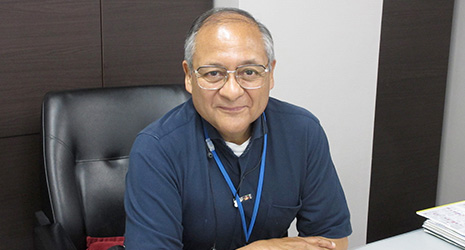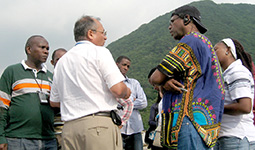Home > Highlighting JAPAN > Highlighting Japan September 2016 > Home Away from Home
Highlighting JAPAN


The Geothermal Man
Mexican-born geothermal power consultant Enrique M. Lima Lobato is working to popularize geothermal power use around the world.
Geothermal power is a renewable energy source that works by extracting steam from subterranean groundwater and using it to drive turbines and generate power. This method of power generation emits only very small amounts of carbon dioxide (CO2) emissions, a gas that contributes to global warming.
Japan is situated along the Ring of Fire and is said to be ranked third in the world — after the United States and Indonesia — for the amount of useable geothermal resources at its disposal. The company leading geothermal power generation in Japan is Kyushu Electric Power Co., Inc., which has geothermal power stations at five locations in the Kyushu region.
Enrique M. Lima Lobato is currently Executive Officer of West Japan Engineering Consultants, Inc., a subsidiary of Kyushu Electric Power Company and Senior Reservoir Engineer of the Geothermal Business Division. Lima comes from Mexico, another country situated along the Ring of Fire. He studied nuclear power engineering at the National Autonomous University of Mexico, and visited Japan in 1971 as part of the first group of participants in an overseas study exchange program between Mexico and Japan.
“As part of the study program, we visited a Toshiba factory, where the massive turbines to be used in Mexico’s geothermal power plants were being made,” reflects Lima. “The generation of geothermal power in Mexico using those turbines was literally just beginning, and from that point on I became engrossed with geothermal power.”
Lima went on to study geothermal energy in detail at Kyushu University, and joined West Japan Engineering Consultants, Inc. (West JEC) in 1984.
Lima’s current work involves geothermal power-related consulting in locations around the world. Islands from Southeast Asia to Oceania which lie along the Ring of Fire, the American and the East African continents — situated over the African Great Rift Valley trench — all have good conditions for geothermal power generation. However, the survey and development work needed to identify locations where subterranean steam can be efficiently extracted and high availability geothermal power plants can be built requires a great deal of time and money. For this reason, spreading understanding of geothermal power to governments, banks and other sources of funding is another important part of Lima’s job. In the 1980s, Lima visited several Japanese institutions which provide overseas assistance as well as multilateral finance institutions based in the United States and preached passionately about the mechanisms and effective use of geothermal power, in order to help further the spread of geothermal power in developing countries. The fruit of this work helped to promote projects around the world, some of which were executed by West JEC with the participation of Lima’s expertise, such as geothermal development surveys in Southeast Asia, the Middle East, North, Central and South America, and East Africa. Several of these projects have geothermal power plants already in operation or under construction, the most recent ones being in Kenya and Indonesia. The Japan International Cooperation Agency (JICA), in addition to financing geothermal projects has also invited experts and other geothermal power affiliates to Japan in order to hold training seminars in which West JEC and Lima have actively participated.
Geothermal power also has the advantage that the steam used in power generation can be reused. In Kenya, when he visited the country to participate in a project, Lima saw locals covering a source of steam rising out of the ground with banana leaves, and collecting and using the condensed water droplets for drinking water.
“I thought that it was a fantastic idea. After seeing that I came up with the idea for a method of reusing the steam released from geothermal power plants to produce potable water,” he says. After fulfilling its role of driving the generator turbines, the steam used in geothermal plants is returned to water by condensers. This water still maintains a high enough temperature to be used in cascade fashion in some other industrial processes. Geothermal heat in abandoned geothermal wells can also be used in secondary applications. Lima suggested this idea to his counterparts in Kenya, and currently geothermal heat from abandoned wells is used in greenhouses for growing roses (one of Kenya’s major exports), close to the Olkaria geothermal power station. However, the idea of producing potable water from geothermal condensate has yet to be realized. When this is achieved, geothermal will provide both power and water solutions for areas with dry climates such as in Kenya, Mexico, the U.S.A., and the high Andes in South America.
“Mexico has the world’s third largest geothermal power station in terms of power output, but the country is still not making effective use [of geothermal resources] for purposes other than power generation,” says Lima. “I want to plant trees and use the water produced by geothermal power stations to grow them, and turn Mexico into a land of greenery. That is my dream.”
© 2009 Cabinet Office, Government of Japan







